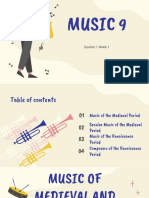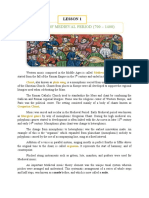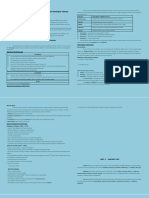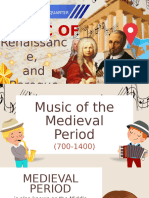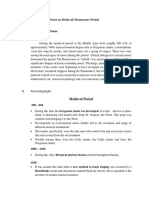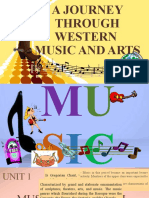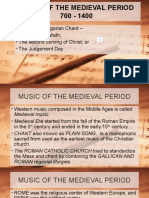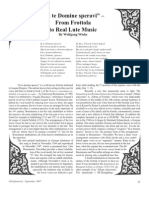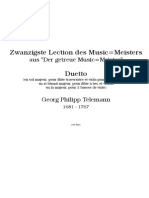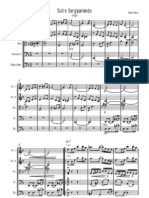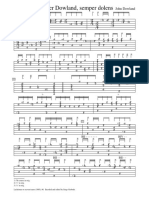Finance Review PDF
Finance Review PDF
Uploaded by
guevarrasakura09Copyright:
Available Formats
Finance Review PDF
Finance Review PDF
Uploaded by
guevarrasakura09Original Title
Copyright
Available Formats
Share this document
Did you find this document useful?
Is this content inappropriate?
Copyright:
Available Formats
Finance Review PDF
Finance Review PDF
Uploaded by
guevarrasakura09Copyright:
Available Formats
MUSIC REVIEWER
TEXT SETTING in writing Gregorian Chant
MUSIC OF MEDIEVAL PEIOD
The Western music tradition and religious SYLLABIC
music development can be traced back in There is one assigned note for each syllable of text.
NEUMATIC
Europe during the medieval period from
A group of neumes is assigned to one syllable of
400 CE to 1400 CE. It is called the Middle
text.
Ages, referring between the fall of the Roman
MELISMATIC
Empire and the age of reawakening and
There are many notes assigned to one syllable of
discovery. text, usually combining several groups of neumes.
PSALMODIC
There were many kinds of music created during the There are many syllables assigned to one note of
Middle Ages: text.
Music for the knights
DEVELOPMENT OF MELODY IN MEDIEVAL PERIOD
For the nobles in the castles
Early medieval music was basically monophonic in
Chants for the priests as they celebrated the
texture. The medieval period, which spans from the
Christian services in cathedrals and
5th century to the 15th century, was a significant
monasteries.
era in the development of Western this tine din the
emilant omele dy During
GREGORIAN CHANT
plainchant (also known as Gregorian chant), which
Gregorian Chant was the official music of the
heavily influenced the early forms of melodic
Roman Catholic Church. It Is referred to after Pope
writing and organization.
Gregory I the Great. It is also named as plainsong or
plainchant. Guillaume de Machaut was a French poet and
composer. He was the first to write a
DID YOU KNOW? polyphonic setting of the mass ordinary. In most of
Pope Gregory I is known as the "Father of the his four-part setting, he used the Ars Nova
Christian Worship", during the medieval period techniques of isorhythm, a repeated rhythmic
because of his contributions not only to the pattern throughout one or more voices.
Catholic Church but also to the other Churches.
DID YOU KNOW?
Characteristics of Gregorian Chants Gregorian is a German band headed by Frank
• Monophonic (music that is written for only one Peterson, a German music producer.
voice or part) The band performs Gregorian chant-inspired
• Free meter versions of modern pop and rock songs.
• Usually based on Latin Liturgy
ORGANUM
Use of Neume Notation
An early church polyphony.
MONOPHONIC Organum consist of a Gregorian chant and one or
Monophonic is a musical texture characterized by a more added musical lines above the chant.
single, unaccompanied melodic line. In A development of organum was introduced by
monophonic music, there is only one voice or Perotin and Leonin.
instrument performing the melody without any
Organum is a form of early polyphony that
harmonies, chords, or additional voices.
emerged in Western music during the medieval
Neume - it is a Gregorian notations that uses period. It is considered one of the earliest forms of
different signs, which are notes sung on single harmony in Western music and was an essential
syllable. step in the development of multi-voice music.
POLYPHONY Trouveres were medieval poets and musicians who
Polyphony is a musical texture that involves thrived in the northern regions of present-day France
the simultaneous sounding of two or more during the High Middle Ages. They were part of the
independent melodic lines. Polyphonic music same cultural movement of courtly love as the
contrasts with monophonic music, which troubadours in the southern regions of France.
consists of a single melodic line without ADAM DE LA HALLE
additional voices or harmonies. Adam de la Halle, also known as Adam le Bossu
(Adam the Hunchback), was a prominent French
MOTET poet, musician, and playwright of the 13th century.
The word motet is believed to come from the He was a talented trouvère, a poet-composer
French word "mot," which means word. The motet belonging to the northern French tradition, and is
evolved from the practice of adding new words to considered one of the most significant medieval
already existing music. composers and poets.
LE JEU DE ROBIN ET DE MARION
Motet is unaccompanied polyphonic choral music
The Play of Robin and Marian)
associated with Western music. Motets were
Adam de la Halle is best known for his theatrical
composed for secular as well as religious functions.
work "Le Jeu de Robin et de Marion" (The Play of
MASS Robin and Marion), which is considered one of the
The Mass in the medieval period was a central form earliest secular plays with music.
of musical expression and a cornerstone of
Western liturgical music. It is a sacred choral It is a pastoral play with elements of comedy and
composition that forms the core of the Catholic romance, and it features dialogues interspersed
Church's worship service, known as the Eucharistic with songs. The play is set in the countryside and
liturgy. tells the story of a shepherdess named Marion and
her lover, Robin.
The Mass is a reenactment of the Last Supper,
where Christians believe Jesus instituted the
MUSICAL INSTRUMENTS
sacrament of the Eucharist.
Part of the Mass
The Ordinary Mass includes five sections that
remain the same in every Mass: Kyrie, Gloria,
Credo, Sanctus, and Agnus Dei.
The Proper Mass refers to the parts of the
liturgy that change daily and are specific to the
particular liturgical occasion, such as the Introit,
Gradual, Alleluia (or Tract), Offertory, and
Communion.
TROUBADOURS
Troubadours came from the word trobar meaning
"to compose", "to discuss", or "to find".
Troubadours were medieval poets and musicians
who flourished in the southern regions of present-
day France during the High Middle Ages. They were
part of a larger cultural movement known as
courtly love, which celebrated refined manners,
chivalry, and romantic devotion.
Similar to medieval period, the vocal music during the
Renaissance was more significant than instrumental
music. Renaissance composers wrote music to
enhance the meaning and emotion of the text.
VOCAL FORMS OF RENAISSANCE MUSIC
SACRED MUSIC IN THE RENAISSANCE
The two main forms of sacred music during
Renaissance period are the motet and the mass.
The motet and the mass are similar in style but the
mass has a longer composition.
RENAISSANCE MOTET
The motet was another essential form of
Renaissance sacred music. It was a polyphonic
choral composition with a religious text, often in
Latin. Motets were used in various liturgical
settings, such as during feasts, special occasions,
and processions.
JOSQUIN DEZ PREZ
DID YOU KNOW?
Josquin des Prez was a Franco-Flemish master of
QUADRIVIUM CURRICULUM
Renaissance music. He spent much of his life in
Since the time of Plato up to the Middle Ages music
Italy serving the papal choir and in dukes' in private
was viewed not as an art but as a science. It was
chapels. His masses, motets, and secular vocal
studied in the schools along with astronomy,
pieces powerfully influenced other composers and
arithmetic, and geometry.
were admired enthusiastically by music lovers
including Martin Luther.
MUSIC OF RENAISSANCE PEIOD
Introduction RENAISSANCE MASS
The Renaissance period was a historical era that• The Renaissance Mass, also known as the
spanned approximately from the 14th to the 16th Polyphonic Mass, was a significant genre of sacred
century. It marked a significant cultural, artistic, music that flourished during the Renaissance
and intellectual rebirth in Europe following the period. It refers to a musical setting of the texts of
Middle Ages. the Ordinary of the Mass, a central liturgical service
in the Catholic Church. The Ordinary of the Mass
The term "Renaissance" comes from the French
consists of five fixed parts: Kyrie, Gloria, Credo,
word for "rebirth," and it encapsulates the revival
Sanctus, and Agnus Dei.
of interest in classical learning, humanism, and a
renewed focus on individual creativity. GIOVANNI PIERLUIGI DA PALESTRINA
Giovanni Pierluigi da Palestrina, often referred to
Renaissance period is also known as period of
simply as Palestrina, was an Italian composer of the
"Golden Age of Polyphony"
Renaissance period. He lived from around 1525 to
1594 and is widely regarded as one of the most
Music of Renaissance
significant and influential composers in the history
Renaissance music is known for its polyphonic
of Western classical music.
texture, where multiple independent melodic lines
are sung or played simultaneously
GUiLLAUME DUFAY THOMAS MORLEY
Guillaume Dufay was a prominent composer of the Promes Moriey ( ce 1557-1602 ) English composer,
Renaissance period. He lived from around 1397 to 1474 organist, and theorist during the Renaissance
and is considered one of the leading figures in the period. He was a significant figure in the
transition from the medieval to the Renaissance style development of English music. He has been called
of music. Dufay composed a wide range of music, the "Father of English madrigal" because of his
including Masses, motets, chansons (French secular great contribution in this musical style.
songs), and other vocal and instrumental works. His
CLAUDIO MONTEVERDi
works are known for their elegance, lyrical melodies,
Claudio Monteverdi (1567-1643) was an Italian
and sophisticated use of counterpoint.
composer and one of the most influential figures in
SECULAR MUSiC OF RENAiSSANCE PERIOD the transition from the Renaissance to the Baroque
Secular music flourished during the Renaissance era. Monteverdi was also a prolific composer of
period (approximately 15th to early 17th century) in madrigals, a popular secular vocal form during the
Europe. It encompassed a wide range of musical Renaissance. His madrigals are known for their
genres and forms, reflecting the rich cultural emotional depth, harmonic innovations, and
diversity and the changing societal values of the expressive word-painting.
time.
Stile concitato, meaning "agitated style" in Italian,
MADRIGAL is a musical technique used by Claudio Monteverdi.
The madrigal was a popular and highly significant It is characterized by rapid repeated notes or
secular vocal music form that flourished during the chords, which create a sense of agitation and
Renaissance period particularly in Italy. It became excitement in the music. Introducing also such
one of the most important and expressive genres of novel sound effects as the string tremolo and
Renaissance secular music. pizzicato.
The madrigal became a popular form of
entertainment among the educated elite, and its
expressive qualities made it appealing to both
performers and audiences. It was an important
medium through which composers could explore
and showcase their skills in vocal polyphony and
expressive word-setting.
CHARACTERISTICS OF MADRIGAL
Madrigals were typically written for small vocal
ensembles, ranging from three to six voices, and
they were characterized by their polyphonic
texture.
Madrigals were often set to short poems or
lyrics that dealt with themes of love, nature,
passion, and human emotions.
Madrigalisms, also known as "word-painting,"
involved specific musical devices to depict the
meaning of individual words in the text.
The most common form of the madrigal was
the five-part madrigal, which had five vocal
lines (SATTB), with the soprano, alto, tenor, and
bass voices accompanied by a fifth voice,
usually a higher tenor or alto voice.
You might also like
- MUSIC 9 Quarter 1 - History of Western Music (For Students)No ratings yetMUSIC 9 Quarter 1 - History of Western Music (For Students)5 pages
- UNIT 1: Music of Medieval, Renaissance, and Baroque PeriodsNo ratings yetUNIT 1: Music of Medieval, Renaissance, and Baroque Periods2 pages
- History of Western Music (Medieval, Renaissance, Baroque)No ratings yetHistory of Western Music (Medieval, Renaissance, Baroque)7 pages
- Music 9 1 Quarter MUSIC OF THE MEDIEVAL (700-1400), RENAISSANCE (1400-1600), AND BAROQUE (1685-1750) PERIODS100% (1)Music 9 1 Quarter MUSIC OF THE MEDIEVAL (700-1400), RENAISSANCE (1400-1600), AND BAROQUE (1685-1750) PERIODS7 pages
- History of Western Classical Music I Contributions of Philosophers or Theorists To The Historical Development of MusicNo ratings yetHistory of Western Classical Music I Contributions of Philosophers or Theorists To The Historical Development of Music6 pages
- MUSIC 9 Q1 Vocal and Instrumental Music of Medieval Renaissance and Baroque PeriodsNo ratings yetMUSIC 9 Q1 Vocal and Instrumental Music of Medieval Renaissance and Baroque Periods54 pages
- Music 9:: Music of Medieval, Renaissance and Baroque Periods100% (1)Music 9:: Music of Medieval, Renaissance and Baroque Periods11 pages
- Music of Medieval, Renaissance and Baroque PeriodNo ratings yetMusic of Medieval, Renaissance and Baroque Period3 pages
- Music of Medieval, Renaissance and Baroque Periods100% (1)Music of Medieval, Renaissance and Baroque Periods31 pages
- Unit 1 Lesson 1 The Music of The Medieval Period (700-1400)No ratings yetUnit 1 Lesson 1 The Music of The Medieval Period (700-1400)12 pages
- Music in The Medieval Period (Middle Ages 500-1450) I. What Is Medieval?No ratings yetMusic in The Medieval Period (Middle Ages 500-1450) I. What Is Medieval?4 pages
- Music 9:: Music of Midieval, Renaissance and Baroque PeriodsNo ratings yetMusic 9:: Music of Midieval, Renaissance and Baroque Periods17 pages
- Music of Medieval, Renaissance, and Baroque PeriodNo ratings yetMusic of Medieval, Renaissance, and Baroque Period35 pages
- A Treasury of Early Music: Masterworks of the Middle Ages, the Renaissance and the Baroque EraFrom EverandA Treasury of Early Music: Masterworks of the Middle Ages, the Renaissance and the Baroque Era3.5/5 (4)
- Great Musical Composers German, French, and ItalianFrom EverandGreat Musical Composers German, French, and ItalianNo ratings yet
- IMSLP549279-PMLP886530-Adiu Mes Amours2.0No ratings yetIMSLP549279-PMLP886530-Adiu Mes Amours2.02 pages
- "In Te Domine Speravi" - From Frottola To Real Lute Music100% (2)"In Te Domine Speravi" - From Frottola To Real Lute Music7 pages
- In Darkness Let Me Dwell: John Dowland 120 120 120No ratings yetIn Darkness Let Me Dwell: John Dowland 120 120 1209 pages
- Listening Guide: Thomas Aquinas (1225-1274) Plainchant Hymn, Pange LinguaNo ratings yetListening Guide: Thomas Aquinas (1225-1274) Plainchant Hymn, Pange Lingua8 pages
- IMSLP396488-PMLP136195-Schütz H - Deus Misereatur Nostri, SWV 55 - EN254-2 (2015)No ratings yetIMSLP396488-PMLP136195-Schütz H - Deus Misereatur Nostri, SWV 55 - EN254-2 (2015)11 pages
- Famous Composers in Renaissance Period PDF100% (2)Famous Composers in Renaissance Period PDF16 pages
- Just The Way You Are (Barry White) - 14No ratings yetJust The Way You Are (Barry White) - 1426 pages
- Intagible Self - Full Score - Georgina DerbezNo ratings yetIntagible Self - Full Score - Georgina Derbez17 pages
- Velislav Zaimov - Sonata For Oboe and BassoonNo ratings yetVelislav Zaimov - Sonata For Oboe and Bassoon13 pages
- MUSIC 9 Quarter 1 - History of Western Music (For Students)MUSIC 9 Quarter 1 - History of Western Music (For Students)
- UNIT 1: Music of Medieval, Renaissance, and Baroque PeriodsUNIT 1: Music of Medieval, Renaissance, and Baroque Periods
- History of Western Music (Medieval, Renaissance, Baroque)History of Western Music (Medieval, Renaissance, Baroque)
- Music 9 1 Quarter MUSIC OF THE MEDIEVAL (700-1400), RENAISSANCE (1400-1600), AND BAROQUE (1685-1750) PERIODSMusic 9 1 Quarter MUSIC OF THE MEDIEVAL (700-1400), RENAISSANCE (1400-1600), AND BAROQUE (1685-1750) PERIODS
- History of Western Classical Music I Contributions of Philosophers or Theorists To The Historical Development of MusicHistory of Western Classical Music I Contributions of Philosophers or Theorists To The Historical Development of Music
- MUSIC 9 Q1 Vocal and Instrumental Music of Medieval Renaissance and Baroque PeriodsMUSIC 9 Q1 Vocal and Instrumental Music of Medieval Renaissance and Baroque Periods
- Music 9:: Music of Medieval, Renaissance and Baroque PeriodsMusic 9:: Music of Medieval, Renaissance and Baroque Periods
- Music of Medieval, Renaissance and Baroque PeriodsMusic of Medieval, Renaissance and Baroque Periods
- Unit 1 Lesson 1 The Music of The Medieval Period (700-1400)Unit 1 Lesson 1 The Music of The Medieval Period (700-1400)
- Music in The Medieval Period (Middle Ages 500-1450) I. What Is Medieval?Music in The Medieval Period (Middle Ages 500-1450) I. What Is Medieval?
- Music 9:: Music of Midieval, Renaissance and Baroque PeriodsMusic 9:: Music of Midieval, Renaissance and Baroque Periods
- Music of Medieval, Renaissance, and Baroque PeriodMusic of Medieval, Renaissance, and Baroque Period
- A Treasury of Early Music: Masterworks of the Middle Ages, the Renaissance and the Baroque EraFrom EverandA Treasury of Early Music: Masterworks of the Middle Ages, the Renaissance and the Baroque Era
- Great Musical Composers German, French, and ItalianFrom EverandGreat Musical Composers German, French, and Italian
- Eighteenth Century French Composers, Vol. XIIIFrom EverandEighteenth Century French Composers, Vol. XIII
- "In Te Domine Speravi" - From Frottola To Real Lute Music"In Te Domine Speravi" - From Frottola To Real Lute Music
- In Darkness Let Me Dwell: John Dowland 120 120 120In Darkness Let Me Dwell: John Dowland 120 120 120
- Listening Guide: Thomas Aquinas (1225-1274) Plainchant Hymn, Pange LinguaListening Guide: Thomas Aquinas (1225-1274) Plainchant Hymn, Pange Lingua
- IMSLP396488-PMLP136195-Schütz H - Deus Misereatur Nostri, SWV 55 - EN254-2 (2015)IMSLP396488-PMLP136195-Schütz H - Deus Misereatur Nostri, SWV 55 - EN254-2 (2015)











